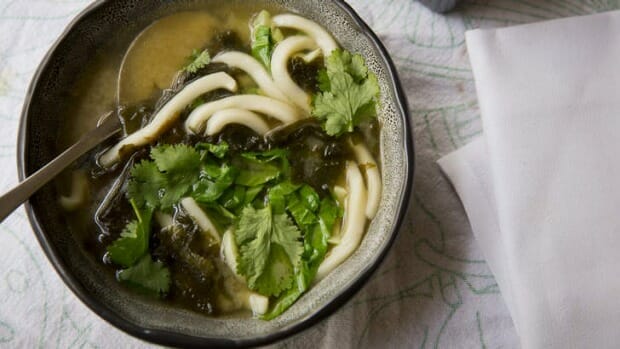Wakame Miso Ramen is one of the best-known and most popular types of ramen in Japan. This dish combines the flavor of wakame with the rich flavor of miso paste. And, This soup is the perfect combination of tofu and kombu.
Japanese Wakame Miso Ramen Recipes


Wakame Miso Ramen
Equipment
Ingredients
- 1 cup dried wakame seaweed
- ¾ cup Light Miso Tare with Shiro Miso
- 5 cups Vegetarian Clear Soup
- 1⅓ pounds noodles fresh, such as Chukasuimen
- Negi
Instructions
- Soak the wakame in water for about 20 minutes. Bring a medium saucepan of water to a boil over medium-high heat and blanch the wakame for 2 minutes. Remove and set aside with the rest of the toppings.
- With all your ingredients ready to go, bring a large pot of water to a boil over medium-high heat.
- Heat your ramen bowls by filling them halfway with hot water. The bowls don’t need to be scalding, but they should be hot to the touch. Dump out the hot water and dry the bowls with some paper towels or a clean towel.
- Put the tare and soup in a medium saucepan. Mix and bring to a simmer over low heat.
- Cook the noodles in the large pot of boiling water. Ramen that hasbeen cut to a standard thickness (about 1 mm) will cook in 1 to 2 minutes.
- About 30 seconds before the noodles are finished cooking, ladle the soup into the ramen bowls.
- Drain the noodles, taking care to shake off as much excess water as you can. Carefully place some noodles in each bowl of soup, keeping them tidy.
- Place some wakame and a sprinkle of negi neatly on the ramen. Serve immediately.
Video
Notes
Nutrition
© Food And Meal
This website provides approximate nutrition information for convenience and as a courtesy only. Nutrition data is gathered primarily from the Spoonacular Database, whenever available, or otherwise other online calculators.
Other ways to making Wakame Miso Ramen

To make this delicious noodle, you will need to prepare a stock using vegetables and kombu, which should be simmered for at least 15 minutes. Once the kombu is soaked, place the wakame and miso paste in the stock. Once the broth is simmering, add the cabbage and wakame, and cook for an additional 10-15 minutes. The kombu and cabbage should be added to the broth, and the kombu should be removed before adding the nori sheet. Once the stock has cooled down, you can add the silken tofu and wakame.
Once you have finished boiling the kombu, add the wakame and tofu to the soup. Be sure to leave the kombu flakes in the water for about five minutes. When the wakame has soaked, take it out of the water and place it in a medium bowl. When it is fully dissolved, add the dashi and tofu. Once the tofu has been absorbed into the broth, you are ready to serve.
Start by putting the kombu in the pot with a cup of water. Do not let the kombu boil because it will make the broth bitter. The kombu should simmer for about 10 minutes. Next, you should add the wakame. Once the wakame has soaked, add the dashi and tofu. Allow the wakame to sit for 5 minutes to absorb the miso paste.
Once the kombu is reconstituted, place it in a pot of water. Do not let the water boil or allow the kombu to become mushy. You should then remove the kombu and simmer the broth for at least 10 minutes. Then, you should place the wakame in a bowl of warm water. While waiting for the dashi broth to simmer, pour the wakame into the soup. Then add the tofu, tsukemen, and garnishes.
To make this dish, you need to rehydrate wakame seaweed. Tofu is diced and added to the dashi stock. After this, add sliced wakame, tofu, and green onions. Do not boil the soup; this can kill the beneficial bacteria that the wakame and miso paste have. When the wakame and tofu are cooked, the broth is ready to serve.
Once the kombu is dissolved, the broth should be brought to a boil and the wakame should be added all at once. The katsuobushi should be allowed to steep for about 10 minutes, until the flakes sink to the bottom of the pot. Once the kombu has dissolved, you should add the dashi and wakame. The wakame should be rehydrated before the tofu is added.
The broth is seasoned with miso and is a staple Japanese dish. In addition to being a staple in the miso soup, wakame can also be used in a variety of other dishes. The seaweed has a very high heat retention rate and can be added to the soup at any time. In addition, it’s very aromatic
FoodAndMeal.Com site is a website you should not miss if you love to cook. Leave a kind comment below to let us know you’re passionate about cooking! And share this post to let your friends know how you are passionate about cuisine.
I'm James F Anderson, a noted sous chef from London and a Le Cordon Bleu alumnus. My career began in a Michelin-starred Parisian eatery, where my blend of classic and contemporary cooking, using seasonal ingredients, earned accolades. Recognized in culinary publications and on cooking shows, I’m committed to mentoring aspiring chefs and delivering memorable dining experiences, marking me as a standout talent in the culinary world.



